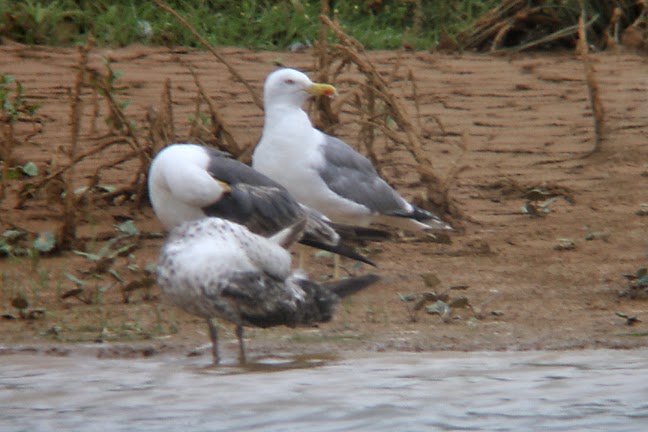An interesting adult gull was present at Shawell A5 Lagoons today. On the water its grey upper parts appeared slightly darker than the nearby adult Herring Gull, but its head shape and size seemed wrong for a Yellow-legged Gull.
Eventually it walked out of the water revealing yellow legs and it had a metal ring, but not a colour ring. A colour ring would have helped sort out a few questions.
In the photos below you can see that it is small headed. Its body is quite slender and it stands in a similar way to a Caspian Gull. Amongst the features that are at odds with it being a Caspian Gull are its shortish legs, its bill being too colourful and its eyes are very pale with no obvious dark pigments. The longest primary feather (P10), which is just visible, looks to be very close to what should be exhibited by a pure Caspian Gull although in my opinion it had just a little bit too much black.
Despite it having yellow legs, I believe this is most likely a Caspian x Herring Gull. Quite a few known Caspian x Herring Gull hybrids have yellow legs.
Birds are already on the move with small numbers of Yellow-legged Gulls arriving from the south and Black-headed Gull numbers are building up having been almost absent for a couple of months. A Common Sandpiper was also at the lagoons today.
Eventually it walked out of the water revealing yellow legs and it had a metal ring, but not a colour ring. A colour ring would have helped sort out a few questions.
In the photos below you can see that it is small headed. Its body is quite slender and it stands in a similar way to a Caspian Gull. Amongst the features that are at odds with it being a Caspian Gull are its shortish legs, its bill being too colourful and its eyes are very pale with no obvious dark pigments. The longest primary feather (P10), which is just visible, looks to be very close to what should be exhibited by a pure Caspian Gull although in my opinion it had just a little bit too much black.
Despite it having yellow legs, I believe this is most likely a Caspian x Herring Gull. Quite a few known Caspian x Herring Gull hybrids have yellow legs.
 |
| Hybrid Gull |
 |
| Hybrid Gull |
Birds are already on the move with small numbers of Yellow-legged Gulls arriving from the south and Black-headed Gull numbers are building up having been almost absent for a couple of months. A Common Sandpiper was also at the lagoons today.



























































